

April 2016, Valentine National Wildlife Refuge, Valentine, NE
The tall grass prairies of the Central Plains states have been disappearing since the Homestead Act was implemented in 1862. In total, 270 million acres, more than 10 percent of the terrestrial land in the United States, was claimed, settled, plowed or grazed.
By the 1930s, The Greater Prairie Chicken had been hunted to near extinction. Due to habitat loss and fragmentation, they can only be found today on small parcels of managed prairie land. Their current population is thought to be less than half a million. In May 2000, they were listed as extirpated in Canada.
Of the three subspecies of prairie chickens, the coastal Heath Hen went extinct in 1932. The Attwater’s Prairie Chicken is highly endangered and found only in two locations in southeast Texas. The Greater Prairie Chicken is threatened, but healthy enough populations remain to still be hunted in six states.
All subspecies of Sharp-tailed Grouse are in decline, due in large part to habitat fragmentation and both species are threatened by the loss of genetic variance because they do not migrate and their remaining isolated populations do not intermingle and breed.
The Valentine National Wildlife Refuge encompasses the largest remaining mid- and tall grass prairie tracts in North America. It was established in 1935 and is managed by the U.S. Fish and Wildlife Service. Along with Fort Niobrara and the John and Louise Seier National Wildlife Refuges, they form the Fort Niobrara National Wildlife Refuge Complex.
After spending a night in a blind watching cranes fly by at Audubon's at Rowe Sanctuary in GIbbon, NE, I drove northwest for about five hours from Omaha to the Valentine National Wildlife Refuge, about 25 miles south of Valentine, NE. It is mostly two-lane highway with lots of slow speed zones as you pass through the small towns en route. It is a lovely drive, but it helps if you like country music and are experienced at passing very large farm vehicles that can’t possibly fit into a single lane.
The refuge has two blinds, positioned annually within close proximity to booming grounds for the Greater Prairie Chicken and the Sharp-tailed Grouse. A booming ground, or lek, is an area where these species perform their nuptial displays accompanied by species specific booming and drumming sounds produced by the movement of air through their wings. In 2016, it was about a half a mile hike from the designated parking area to each blind and you have to be in the blind an hour before sunrise. You’ll hear the birds long before you’ll be able to see or photograph them. You then have to stay in the blinds until the birds leave the lek, which tends to be about 9 a.m. Reservations are required for the blinds, but there is no cost. They each have three metal folding chairs that should be replaced by smaller fabric collapsible folding stools to save space, to say nothing of the experience of sitting on metal chairs in freezing weather.
The blinds can accommodate more than one photographer, but only one reservation is accepted per blind per day, so no one else has access to the blind unless you invite them. It’s difficult for more than one serious photographer to use the blind at a time even though there are viewing portals on three sides. As you might expect, the best action is usually only viewable from one side.
Access to the Sharp-tailed Grouse blind was off Highway 83, the main road through the refuge, but access to the Greater Prairie Chicken blind was off of a five-mile gravel and dirt road that branched off of Highway 83 about three miles further north. From Valentine, it was a 45-60 minute drive to the Prairie Chicken blind parking area and a high clearance four-wheel drive vehicle is recommended. The Sharp-tailed parking area was about a 30-minute drive from Valentine, all on smoothly paved roads. You can't see either blind from the parking areas, so it’s best to scout the hikes beforehand and to carry a handheld GPS. The blinds are easy to find in the daylight, but it’s really dark at 5 a.m.
Since you’re getting up before 4 a.m. anyway, it makes sense to go earlier if it’s a clear dark night so you can photograph the Milky Way moving across the southern sky above the prairie and your blind.
Sunrise in Nebraska in mid-April is around 7 a.m. and the stars begin to fade a little before 6 a.m., which is also when you need to be in the blind, so the timing is perfect. As the eastern sky begins to lighten, you’ll start to hear the Prairie Chickens prancing and dancing around the lek.
Although much of the grass on the lek had been flattened by the birds, there was still a lot of standing grass just waiting to block a clear line of sight, especially when the birds were displaying and they ducked their heads and raised their splayed tail feathers. When the early morning sunlight scrapes the lek, you’ll have lovely warm light, but every foreground and background standing blade of grass will be annoyingly illuminated, so you have to remain attentive when you shoot.
Once you have captured the standard display behavior, that’s when the fun really begins because there’s a lot going on. The males are competing for females, defending their territories and flying about hither and yon. Everything on the lek is inter-related. When one bird moves, the others react, so there is always something interesting to observe and photograph.
Photographing Sharp-tailed Grouse was more challenging for me than photographing Greater Prairie Chickens. I only had one morning in the Grouse blind compared to two in the Prairie Chicken blind, the birds are slightly smaller, there were more of them, they were more hyperactive, the grass was taller, they ducked their heads closer to the ground when displaying and their behaviors were more coordinated.
You may think that having more birds, that all do the same thing at the same time would make photography easier, but it really just made it more difficult to know which birds to follow and there were extended periods where all the birds were just nestled down into the grass, whereas there was always some bird doing something at the Prairie Chicken lek.
The Grouse flew off shortly after 8 a.m. and the lek was shaded until about 7:20 a.m. since the sun rose behind a small hill. Forty minutes is not a lot of time, but it’s one of the few places you can still be totally isolated and photograph one of the great wildlife spectacles that the prairie provides each spring.
©Rich Beckman


April 2016, Sandhill Cranes and Waxing Crescent Moon, Audubon's Rowe Sanctuary, Gibbon, NE
Each spring, visitors are offered the opportunity to spend a night in a blind at the Sanctuary. You enter the blind at 5 p.m. and remain there until retrieved by a guide the next morning. The blind is a small, barren wooden shack equipped with only a porta-potty situated near Sandhill Crane roosts. No food, drink or bedding is supplied and the cost is $250/night.
©Rich Beckman
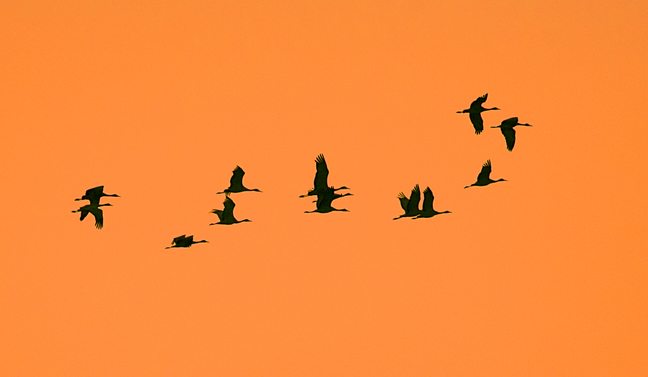

April 2016, Sandhill Cranes, Audubon's Rowe Sanctuary, Gibbon, NE
Each spring, visitors are offered the opportunity to spend a night in a blind at the Sanctuary. You enter the blind at 5 p.m. and remain there until retrieved by a guide the next morning. The blind is a small, barren wooden shack equipped with only a porta-potty situated near Sandhill Crane roosts. No food, drink or bedding is supplied and the cost is $250/night.
©Rich Beckman
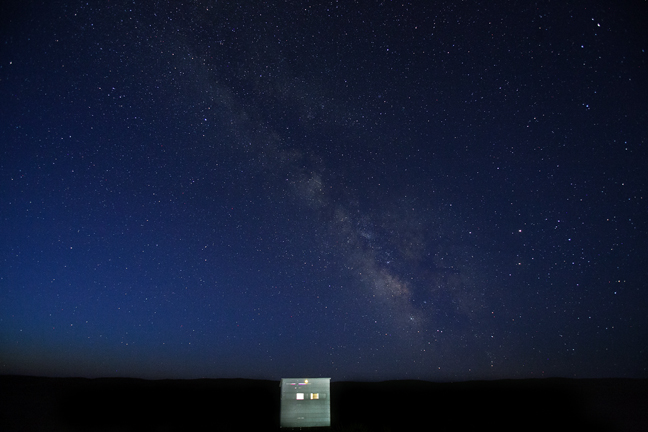

April 2016, Photo Blind, Valentine National Wildlife Refuge, Valentine, NE
The refuge has two blinds, positioned annually within close proximity to booming grounds for the Greater Prairie Chicken and the Sharp-tailed Grouse. In 2016, it was about a half a mile hike from the designated parking area to each blind and you have to be in the blind an hour before sunrise.
©Rich Beckman
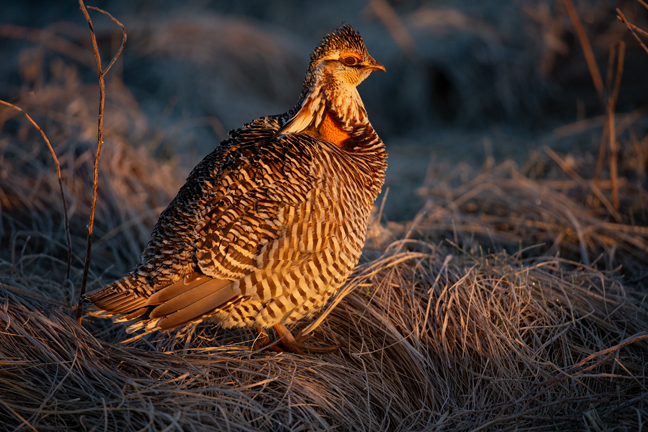

April 2016, Greater Prairie Chicken, Valentine National Wildlife Refuge, Valentine, NE
By the 1930s, The Greater Prairie Chicken had been hunted to near extinction. Due to habitat loss and fragmentation, they can only be found today on small parcels of managed prairie land. Their current population is thought to be less than half a million. In May 2000, they were listed as extirpated in Canada. (1/7)
©Rich Beckman


April 2016, Greater Prairie Chicken, Valentine National Wildlife Refuge, Valentine, NE
By the 1930s, The Greater Prairie Chicken had been hunted to near extinction. Due to habitat loss and fragmentation, they can only be found today on small parcels of managed prairie land. Their current population is thought to be less than half a million. In May 2000, they were listed as extirpated in Canada. (2/7)
©Rich Beckman


April 2016, Greater Prairie Chicken, Valentine National Wildlife Refuge, Valentine, NE
By the 1930s, The Greater Prairie Chicken had been hunted to near extinction. Due to habitat loss and fragmentation, they can only be found today on small parcels of managed prairie land. Their current population is thought to be less than half a million. In May 2000, they were listed as extirpated in Canada. (3/7)
©Rich Beckman
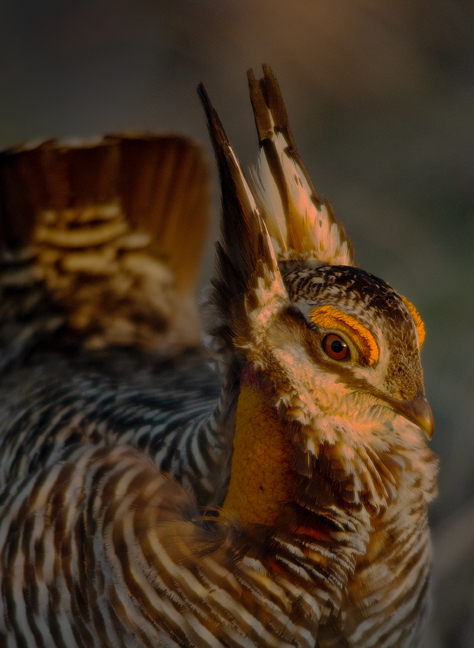

April 2016, Greater Prairie Chicken, Valentine National Wildlife Refuge, Valentine, NE
By the 1930s, The Greater Prairie Chicken had been hunted to near extinction. Due to habitat loss and fragmentation, they can only be found today on small parcels of managed prairie land. Their current population is thought to be less than half a million. In May 2000, they were listed as extirpated in Canada. (4/7)
©Rich Beckman
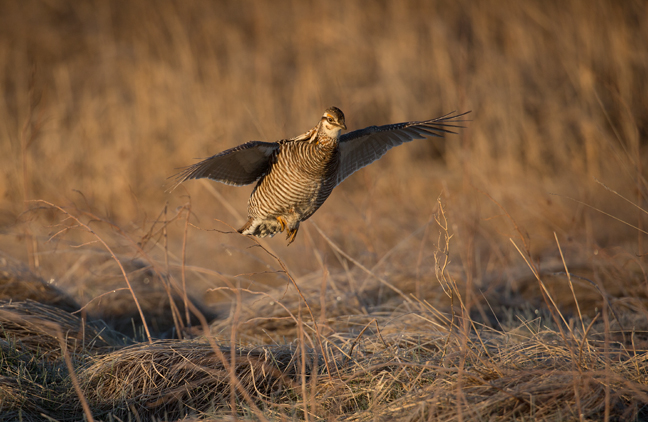

April 2016, Greater Prairie Chicken, Valentine National Wildlife Refuge, Valentine, NE
By the 1930s, The Greater Prairie Chicken had been hunted to near extinction. Due to habitat loss and fragmentation, they can only be found today on small parcels of managed prairie land. Their current population is thought to be less than half a million. In May 2000, they were listed as extirpated in Canada. (5/7)
©Rich Beckman


April 2016, Greater Prairie Chicken, Valentine National Wildlife Refuge, Valentine, NE
By the 1930s, The Greater Prairie Chicken had been hunted to near extinction. Due to habitat loss and fragmentation, they can only be found today on small parcels of managed prairie land. Their current population is thought to be less than half a million. In May 2000, they were listed as extirpated in Canada. (6/7)
©Rich Beckman


April 2016, Greater Prairie Chicken, Valentine National Wildlife Refuge, Valentine, NE
By the 1930s, The Greater Prairie Chicken had been hunted to near extinction. Due to habitat loss and fragmentation, they can only be found today on small parcels of managed prairie land. Their current population is thought to be less than half a million. In May 2000, they were listed as extirpated in Canada. (7/7)
©Rich Beckman
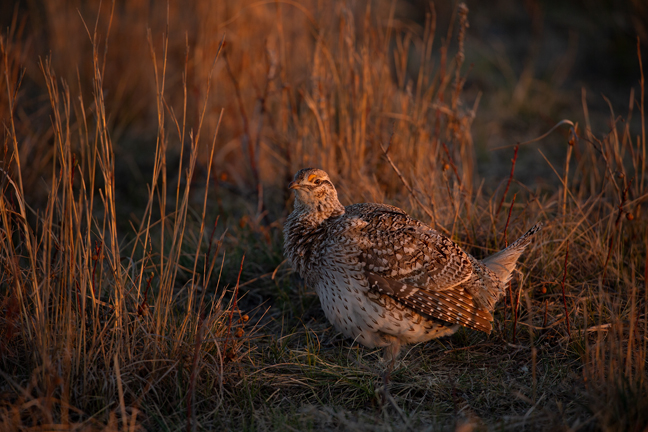

April 2016, Sharp-tailed Grouse, Valentine National Wildlife Refuge, Valentine, NE
All subspecies of Sharp-tailed Grouse are in decline, due in large part to habitat fragmentation and both species are threatened by the loss of genetic variance because they do not migrate and their remaining isolated populations do not intermingle and breed. (1/4)
©Rich Beckman
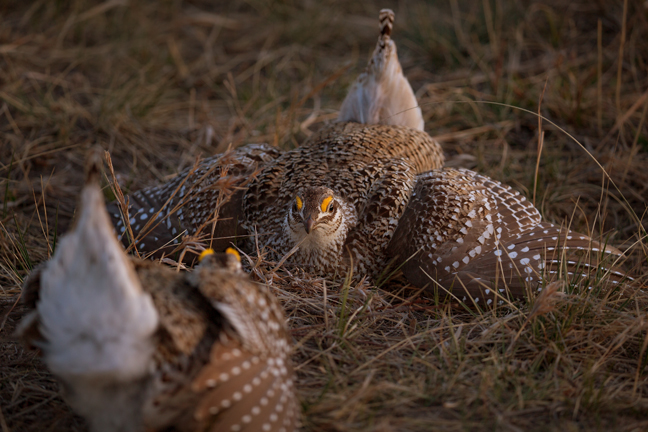

April 2016, Sharp-tailed Grouse, Valentine National Wildlife Refuge, Valentine, NE
All subspecies of Sharp-tailed Grouse are in decline, due in large part to habitat fragmentation and both species are threatened by the loss of genetic variance because they do not migrate and their remaining isolated populations do not intermingle and breed. (2/4)
©Rich Beckman
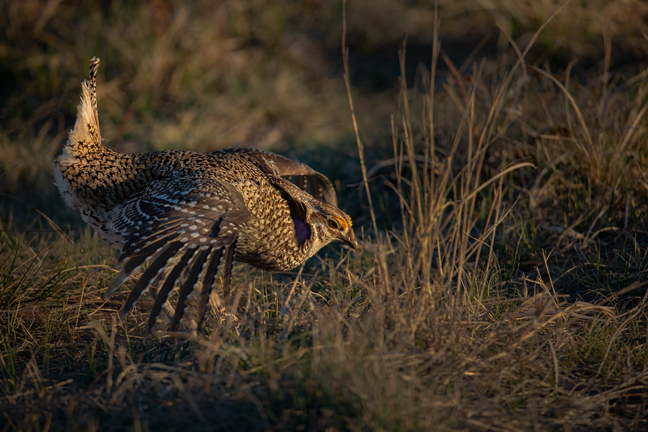

April 2016, Sharp-tailed Grouse, Valentine National Wildlife Refuge, Valentine, NE
All subspecies of Sharp-tailed Grouse are in decline, due in large part to habitat fragmentation and both species are threatened by the loss of genetic variance because they do not migrate and their remaining isolated populations do not intermingle and breed. (3/4)
©Rich Beckman


April 2016, Sharp-tailed Grouse, Valentine National Wildlife Refuge, Valentine, NE
All subspecies of Sharp-tailed Grouse are in decline, due in large part to habitat fragmentation and both species are threatened by the loss of genetic variance because they do not migrate and their remaining isolated populations do not intermingle and breed. (4/4)
©Rich Beckman